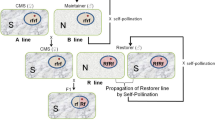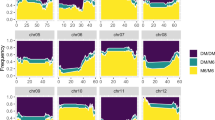Abstract
Bulked segregant analysis and comparative mapping were applied to identify molecular markers linked to the Rfo restorer gene used for the Ogu-INRA cytoplasmic male-sterility system in rapeseed. These markers were then used to localise the radish introgression on the B. napus genetic map constructed from the cross ‘Darmor.bzh’ x ’Yudal’. The introgression mapped on the DY15 linkage group. From the comparison of this latter group to the linkage group constructed on a F2 progeny segregating for the radish introgression, it was concluded that the introgression had occurred through homoeologous recombination, that it was not distal and that it had replaced a B. napus region of around 50 cM. A QTL involved in aliphatic seed glucosinolate content was located on the DY15 linkage group at a position corresponding to one end of the introgression. The DNA markers identified in this study are being used in map-based cloning of the Rfo gene and in marker-assisted selection.
Similar content being viewed by others
Author information
Authors and Affiliations
Additional information
Received: 3 December 1997 / Accepted: 17 December 1997
Rights and permissions
About this article
Cite this article
Delourme, R., Foisset, N., Horvais, R. et al. Characterisation of the radish introgression carrying the Rfo restorer gene for the Ogu-INRA cytoplasmic male sterility in rapeseed (Brassica napus L.). Theor Appl Genet 97, 129–134 (1998). https://doi.org/10.1007/s001220050876
Issue Date:
DOI: https://doi.org/10.1007/s001220050876




